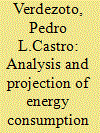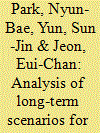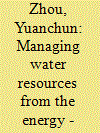|
|
|
Sort Order |
|
|
|
Items / Page
|
|
|
|
|
|
|
| Srl | Item |
| 1 |
ID:
169713


|
|
|
|
|
| Summary/Abstract |
A forecast model for the Ecuador energy sector was elaborated, by using LEAP model, this study aims to analyze the behavior of the energy matrix depending on energy forecast and efficiency policy scenarios, applying a bottom-up analysis and considering the latest politics/infrastructure planning background in Ecuador. The model and considerations proposed will result in a final energy consumption of 158 million BOE in 2030, in which the transportation sector is the main energy consumer. Regarding Ecuador energy planning, of which a critical point is the hydroelectricity available due to the commissioning of new hydro power plants, estimated at 63,513 Gwh in 2030, this value is 3.25 times that generated in 2010. In addition, the energy saving of 15 million BOE is forecast, as well as the reduction in GHG emission related to that saving due to the energy efficiency program PEC, which replaces LPG stoves with induction stoves in Ecuadorian households. Results point out that energy efficiency policies for the transportation sector would reduce oil products (2.97% in the high growth scenario), which could be reallocated to the industrial sector. Finally, another critical point is the rapid decline in the oil self-sufficiency, estimated at 15 years counted from 2030.
|
|
|
|
|
|
|
|
|
|
|
|
|
|
|
|
| 2 |
ID:
117244


|
|
|
|
|
| Publication |
2013.
|
| Summary/Abstract |
This paper analyzes the energy, environmental and economic influences of three electricity scenarios in Korea by 2050 using the "Long-range Energy Alternatives Planning system" (LEAP) model. The reference year was 2008. Scenarios include the baseline (BL), new governmental policy (GP) and sustainable society (SS) scenarios. The growth rate of electricity demand in the GP scenario was higher than that of the BL scenario while the growth rate in the SS scenario was lower than that of the BL scenario.
Greenhouse gas emissions from electricity generation in 2050 in the BL and GP scenarios were similar with current emissions. However, emissions in 2050 in the SS scenario were about 80% lower than emissions in 2008, because of the expansion of renewable electricity in spite of the phase-out of nuclear energy.
While nuclear and coal-fired power plants accounted for most of the electricity generated in the BL and GP scenarios in 2050, the SS scenario projected that renewable energy would generate the most electricity in 2050. It was found that the discounted cumulative costs from 2009 to 2050 in the SS scenario would be 20 and 10% higher than that of the BL and GP scenarios, respectively.
|
|
|
|
|
|
|
|
|
|
|
|
|
|
|
|
| 3 |
ID:
163555


|
|
|
|
|
| Summary/Abstract |
As one of the most developed provinces in China, Jiangsu province is facing both energy and water stresses. The impact of energy production on water resource remains to be seen, especially in terms of a changing climate. In this study, we adopt a Long-range Energy Alternatives Planning System (LEAP) model combined with plant-level data to study the impact of energy policies on water resources management. The results indicate that energy efficiency improvements and industry structure optimization can result in 40% and 33% water withdrawal savings respectively in the future depending on the level of optimization. With several integrated measures, total water use can meet the 2030 targets set by the Jiangsu provincial government. Shifts in cooling technology can bring significant water-savings benefits and help fulfill water use-control targets. Furthermore, we find that the Suzhou and Xuzhou administrative areas will experience power output efficiency reductions and will need more water in 2030 under the RCP45 and RCP85 scenarios. More efforts are needed to mitigate climate change and offset its negative impact on energy and water resource. The results of this study will be informative for both resource management and policy design.
|
|
|
|
|
|
|
|
|
|
|
|
|
|
|
|
|
|
|
|
|